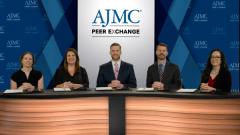
Real-World Evidence in HIV
Key opinion leaders discuss the value of real-world evidence in the management of HIV.
Episodes in this series

Adam C. Welch, PharmD: Let’s talk a little about the confluence of real-world evidence with treatment guidelines. We spoke about how the guidelines are well done from your perspective, but how do you take what you’ve seen in patients many times before vs what HHS [Department of Health and Human Services] is putting out as treatment guidelines?
Christian B. Ramers, MD, MPH, FIDSA, AAHIVS: We always believe clinical trials to be an idealized patient population. I work in a federally qualified health center. I have many patients who are homeless, and they never would have made it into the clinical trial to get that 90% success rate. So I want to see what happens in the real world. Typically, the suppression rates are a little lower. I also think real-world evidence is a way of looking at some of the margins. We talked about long-acting injectables that are only recommended for those who are biologically suppressed. But I have patients who come to clinic all the time because they live down the street. Maybe homeless individuals who are very close but can’t take pills. That population doesn’t show up in the guidelines. The clinical trial evidence isn’t there, but there are real-world studies. One of them, from Ward 86 at [Zuckerberg] San Francisco [General Hospital and Trauma Center], uses injectable therapies in harder-to-treat populations, and there’s reasonable efficacy in those difficult situations. Real-world evidence gives us 2 things. It gives us more confidence in patients who look like ours, and it also allows us to explore more innovative aspects of HIV care.
Ann Khalsa, MD, MSEd, FAAFP, AAHIVS: But it also speaks to some of the underlying principles of making that effective. You’re talking about homeless individuals and Ward 86, which is the HIV ward in San Francisco. They’re giving this injectable treatment to a large homeless population. They’ve had great success, but they had a huge, dedicated-case management team who went out and tracked these folks down. When we come back to social determinants of health, it takes a village. It takes a community of individuals who can help support individuals who are otherwise facing a lot of hurdles and roadblocks. We can prescribe medicines; that’s the easy job. We’re not the ones navigating their life. Many of them have hurdles that are nearly unnavigable, that need support, or we can’t effectively treat them.
Christian B. Ramers, MD, MPH, FIDSA, AAHIVS: This is a perfect time to bring up the Ryan White [HIV/AIDS] Program, which we’ve mentioned it a lot here. We have a very good outcome measure that tells us how we’re doing, and that’s virological suppression. I looked at the data in California. Overall, our virological suppression is about 65%, which is not great. We can do a lot better than that. The goal of the “end the epidemic” campaigns is to get to at least 90%, maybe 95%. There’s a program called Ryan White. It’s federal legislation that’s implemented at the state level. The magic sauce with Ryan White is it doesn’t provide just drugs and visits. It provides wraparound services that include substance use therapy, mental health therapy, dentistry, housing, food insecurity, insurance help—all these things that get in the way when the patients leave our clinic. The Ryan White Program nationally has a viral suppression rate of 89%, which is better than the private insurance market. For all the payers listening to this, look at Ryan White. All the stuff they’re doing stuff in Florida is great. Look to what Ryan White is doing because they’re taking care of all these very difficult social determinants of health.
Alina Orozco, RN: That’s exactly how we started the Clear Health Alliance program in Florida. I came from the Ryan White area. Then we looked to model it. We brought in those providers. We brought in case managers who had experience with the Ryan White community-based organizations. We work together intuitively. In Florida, our viral load suppression is 69%. We match that. We have 13,000 statewide, and Florida has about 110, 000 to 120,000 individuals living with HIV. Our Medicaid program has a large percentage of individuals living with serious mental illness, food insecurity, housing insecurity, and a lot of the social determinants of health, including homelessness. That’s a testament to having put in the tools, effort, and resources. We have 100 case managers and outreach workers dedicated to this population, and it shows in the evidence of the outcome. We’ve been doing this for 10, 11 years. It can be done, but it takes that dedication. It takes the willingness to work with the payer, the regulatory agencies, the providers, and the community-based organizations and members. Having the members—we call them members or clients or patients—at the center of the decision-making process of what it is that you’re going to offer. What are the benefits that you’re going to offer? Medicaid obviously covers a lot of the medical care, but then we look at the benefits that Medicaid doesn’t cover. Does our population need food, housing, or transportation? Those are key.
Adam C. Welch, PharmD: Ryan White has an 89% viral suppression success rate, and other private providers are in the 60% range. Ryan White is an exemplar program that we should be look to and implement because it’s in the best interest of our patients and their outcomes, both economically and clinically.
Transcript edited for clarity.
Newsletter
Stay ahead of policy, cost, and value—subscribe to AJMC for expert insights at the intersection of clinical care and health economics.




























































